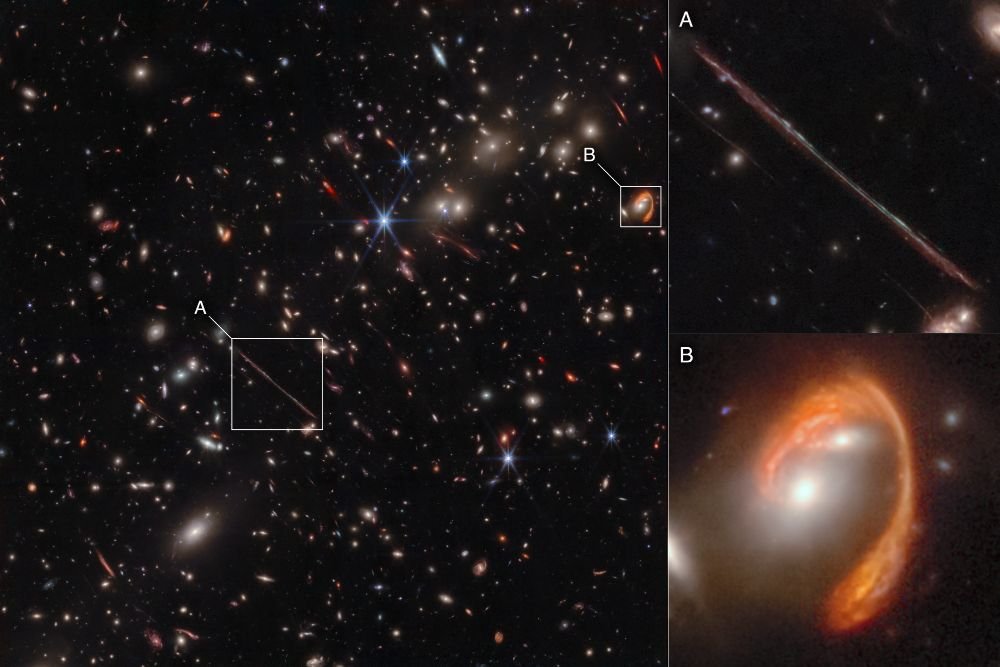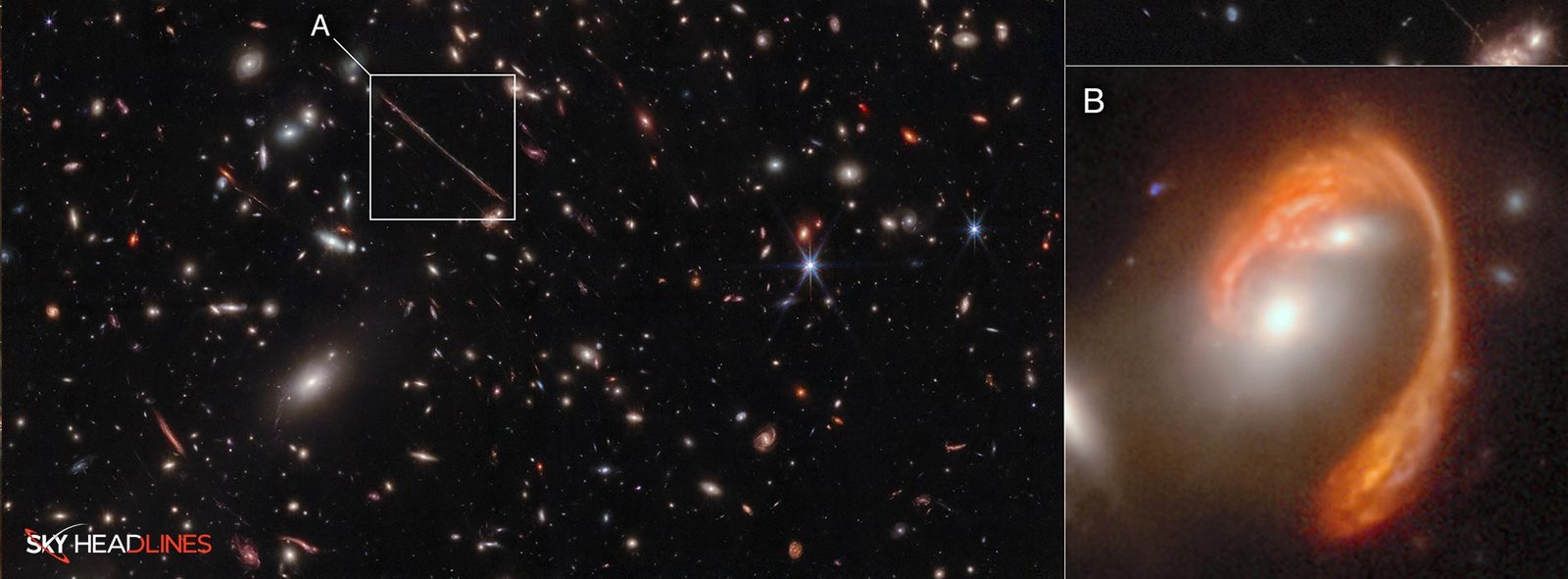EL Gordo is a galaxy cluster, and its phenomenal view has been captured recently by NASA’s James Webb Space Telescope. But one thing that is quite surprising you will find that this galaxy is locate more than 7 billion light-years away.
And one thing that is noteworthy here is that the light from this arc has traveled for a 10.6 billion years before reaching Earth!
What is the Real Meaning of El Gordo?
El Gordo is a cluster that comprises hundreds of galaxies. They came into existence when the universe was approximately 6.2 billion years old. And that obviously making it a “cosmic teenager.” Apart from other interesting things, one thing is the EL Gordo had the title of the most giant cluster which we know. And if you want to know its originality, then it come from Spanish which means “The Fat One.”
Why the Astronomers Studied El Gordo? Gravitational Lensing Phenomenon!
If you are wondering why the scientists, and the research team chose to study El Gordo. Then it was due to its role as a natural cosmic magnifying glass. And it was achieved through a phenomenon called gravitational lensing. This process occurs when a cluster’s potent gravity bends and distorts the light of objects located behind it. This also resembles the effect of an eyeglass lens.
Gravitational lensing enhances the luminosity and enlarges the sizes of distant galaxies, allowing astronomers to study the universe in greater detail. El Gordo, a galaxy cluster known for its high mass, exemplifies this phenomenon.
Team Pearls & Their Contribution in El Gordo:
Therefore, through the gravitational lensing by El Gordo, the brightness of galaxies that are far were boosted, and their sizes are magnified! This impressive lensing effect offers a special window into the far reaches of the universe. And allows researchers like Brenda Frye from the University of Arizona, co-leading the PEARLS-Clusters branch of the Prime Extragalactic Areas for Reionization and Lensing Science (PEARLS) team. They conduct their observations and analysis on El Gordo.
What is El Anzuelo? Let’s Have Some Meaningful Insights
If we look deeper into the details of El Gordo, then we will find the one of the most notable elements. That is a vibrant red arc situated at the upper right. We call it as “El Anzuelo”, and its meaning is The Fishhook!
El Gordo, named by one of Brenda Frye’s students, emits light that has traveled for 10.6 billion years before reaching Earth. This galaxy’s distinctive red color is the result of a combination of reddening by dust within the galaxy itself, as well as cosmological redshift, both occurring due to its immense distance
The Phenomenon of “QUENCHING”!
The research team has successfully determined that the background galaxy, El Gordo, possesses a disk-like shape. This conclusion was reached through meticulous corrections for the lensing distortions. Moreover, El Gordo boasts a diameter of approximately 26,000 light-years, roughly one-fourth the size of our own Milky Way.
Furthermore, their investigations into the galaxy’s star formation history also revealed a fascinating finding, which is none other than the process of quenching. And in this process the star formation rapidly declines, and they was already on the way, and in the center of the galaxy.
Let’s Know the Word of Patrick Kamieneski too!
Patrick Kamieneski from Arizona State University, the lead author of a second paper said:
“We skillfully unraveled the dust veil enveloping the galaxy’s center, where active star formation occurs. Now, with the capabilities of Webb, we can effortlessly peer through this dense curtain of dust. And it will be providing us with an unprecedented opportunity to witness the inner workings of galaxy assembly.”

What is the Reason Behind the Striking Red Color of El Anzuelo?
El Anzuelo’s striking red color come up from a combination of two factors:
- The reddening effect caused by dust within the galaxy itself.
- The cosmological redshift from its incredible distance.
And, the second prominent feature within the image is the pencil-thin gravitational arc, and the scientists gave a nickname it too. “La Flaca” (the Thin One).
This arc belongs to another lensed background galaxy, and its light also took nearly 11 billion years to reach Earth.
Who Lead the Keen Analysis of El Gordo?
The PEARLS-Clusters branch, a part of the PEARLS team, conducted observations related to the discovery of El Gordo. The images taken by the James Webb Space Telescope (JWST) are not only scientifically significant but also awe-inspiring in their breathtaking beauty. These images showcase the remarkable power of gravitational lensing, further enhancing their beauty.
Moreover, his ability to tackle the gravitational lensing also fulfills the vision given by Albert Einstein over a century ago. It also opens up new possibilities for unraveling the secrets of the universe.
How The Theory of Relativity is Corelated with El Gordo Cluster?
Albert Einstein’s theory of general relativity come more than 100 years ago. And it predicted the phenomenon of gravitational lensing. In the case of the El Gordo cluster, we witness this phenomenon come into visuals. The JWST’s remarkable infrared capabilities also allow it to penetrate through dust veils. Which furthermore making it more unique.
The concept of gravitational lensing by Einstein’s theory give us a vision of space and time. It tells us that they are interconnected and malleable just like a skin to a tangible fabric. This 4D “fabric” can warp and ripple based on the presence of masses within it.
The JWST’s ability to observe and analyze gravitational lensing holds great significance in advancing our understanding of the cosmos.
Why the Distant Galaxies Appeared More Younger than the Nearest Galaxies?
As we are talking about El Gordo which is a very distant galaxy, so let’s find more insights about distant galaxies. Besides the objects captured in the Webb image, there are many intriguing elements. Through they might be less prominent.
For instance, Brenda Frye and her team, consisting of nine students ranging from high school to graduate level, made a fascinating discovery. They identified five multiply lensed galaxies that seem to be part of a baby galaxy cluster that was forming around 12.1 billion years ago. Furthermore, there are about a dozen other candidate galaxies that could also be part of this distant cluster, known as El Gordo.
The research team examined whether the properties of these galaxies differed from the ultra-diffuse galaxies or not. And they did find dissimilarities. The galaxies in the distant cluster appeared bluer, younger, more extended. And they displayed a more even distribution throughout the cluster.
These findings suggest that living in the cluster environment for the past 6 billion years has influenced the evolution and characteristics of these galaxies.
Ending Note on Timothy Carleton’s Words:
Timothy Carleton who is link with Arizona State University shares:
“We explored whether these galaxies exhibit any differences compared to the ultra-diffuse galaxies we typically observe in our local universe, and indeed, we found some intriguing variations. Specifically, they appeared bluer, indicating younger stars. And they displayed a more extended and evenly distributed pattern within the cluster. These observations strongly suggest that the cluster environment has played a substantial role in shaping the properties of these galaxies over the course of the last 6 billion years.”
Now, what do you think how are distant galaxies like El Gordo differ from the nearest one? What could be the potential manners of their difference?





